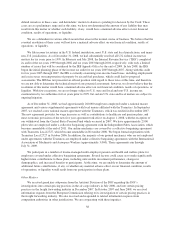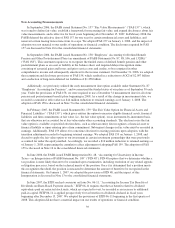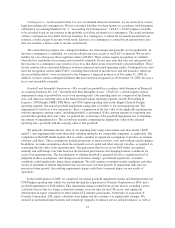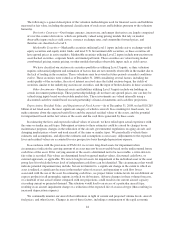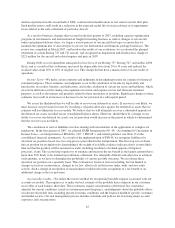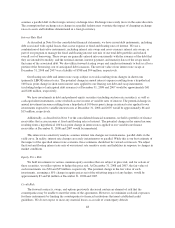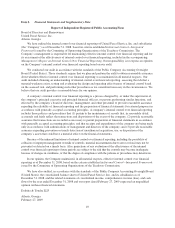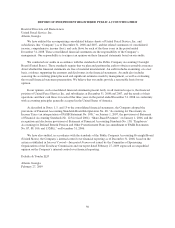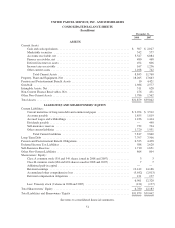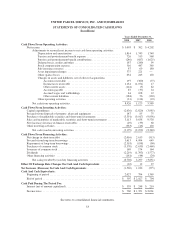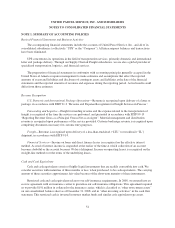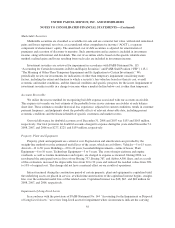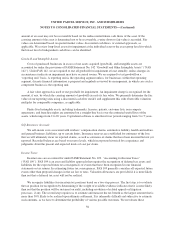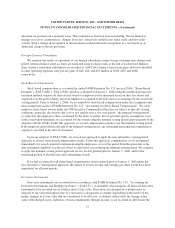UPS 2008 Annual Report Download - page 58
Download and view the complete annual report
Please find page 58 of the 2008 UPS annual report below. You can navigate through the pages in the report by either clicking on the pages listed below, or by using the keyword search tool below to find specific information within the annual report.Item 7A. Quantitative and Qualitative Disclosures about Market Risk
We are exposed to market risk from changes in certain commodity prices, foreign currency exchange rates,
interest rates, and equity prices. All of these market risks arise in the normal course of business, as we do not
engage in speculative trading activities. In order to manage the risk arising from these exposures, we utilize a
variety of foreign exchange, interest rate, equity and commodity forward contracts, options, and swaps.
The following analysis provides quantitative information regarding our exposure to commodity price risk,
foreign currency exchange risk, interest rate risk, and equity price risk. We utilize valuation models to evaluate
the sensitivity of the fair value of financial instruments with exposure to market risk that assume instantaneous,
parallel shifts in exchange rates, interest rate yield curves, and commodity and equity prices. For options and
instruments with non-linear returns, models appropriate to the instrument are utilized to determine the impact of
market shifts. There are certain limitations inherent in the sensitivity analyses presented, primarily due to the
assumption that exchange rates change in a parallel fashion and that interest rates change instantaneously. In
addition, the analyses are unable to reflect the complex market reactions that normally would arise from the
market shifts modeled.
A discussion of our accounting policies for derivative instruments and further disclosures are provided in
Note 15 to the consolidated financial statements.
Commodity Price Risk
We are exposed to changes in the prices of refined fuels, principally jet-A, diesel, and unleaded gasoline.
Currently, the fuel surcharges that we apply to our domestic and international package and LTL services are the
primary means of reducing the risk of adverse fuel price changes. Additionally, we use a combination of options
contracts to provide partial protection from changing fuel and energy prices. The net fair value of such contracts
subject to price risk, excluding the underlying exposures, as of December 31, 2008 and 2007 was an asset
(liability) of $0 and $(179) million, respectively. The potential loss in the fair value of these derivative contracts,
assuming a hypothetical 10% adverse change in the underlying commodity price, would be approximately $0 and
$42 million at December 31, 2008 and 2007, respectively. This amount excludes the offsetting impact of the
price risk inherent in the physical purchase of the underlying commodities.
In the fourth quarter of 2008, we terminated several energy derivatives and received $87 million in cash.
Additionally, in the second quarter of 2006, we terminated several energy derivatives and received $229 million
in cash. These transactions are reported in other investing activities in the statement of cash flows. As these
derivatives qualified for hedge accounting, were designated as hedges, and maintained their effectiveness, the
gains associated with these hedges were recognized in income over the original term of the hedges. The hedges
that were terminated in the fourth quarter of 2008 will be recognized in the income statement through the first
quarter of 2009.
Foreign Currency Exchange Risk
We have foreign currency risks related to our revenue, operating expenses, and financing transactions in
currencies other than the local currencies in which we operate. We are exposed to currency risk from the
potential changes in functional currency values of our foreign currency-denominated assets, liabilities, and cash
flows. Our most significant foreign currency exposures relate to the Euro, the British Pound Sterling and the
Canadian Dollar. We use a combination of purchased and written options and forward contracts to hedge cash
flow currency exposures. These derivative instruments generally cover forecasted foreign currency exposures for
periods of 12 to 24 months. As of December 31, 2008 and 2007, the net fair value of the hedging instruments
described above was an asset (liability) of $241 and $(42) million, respectively. The potential loss in fair value
for such instruments from a hypothetical 10% adverse change in quoted foreign currency exchange rates would
be approximately $239 and $387 million at December 31, 2008 and 2007, respectively. This sensitivity analysis
47



